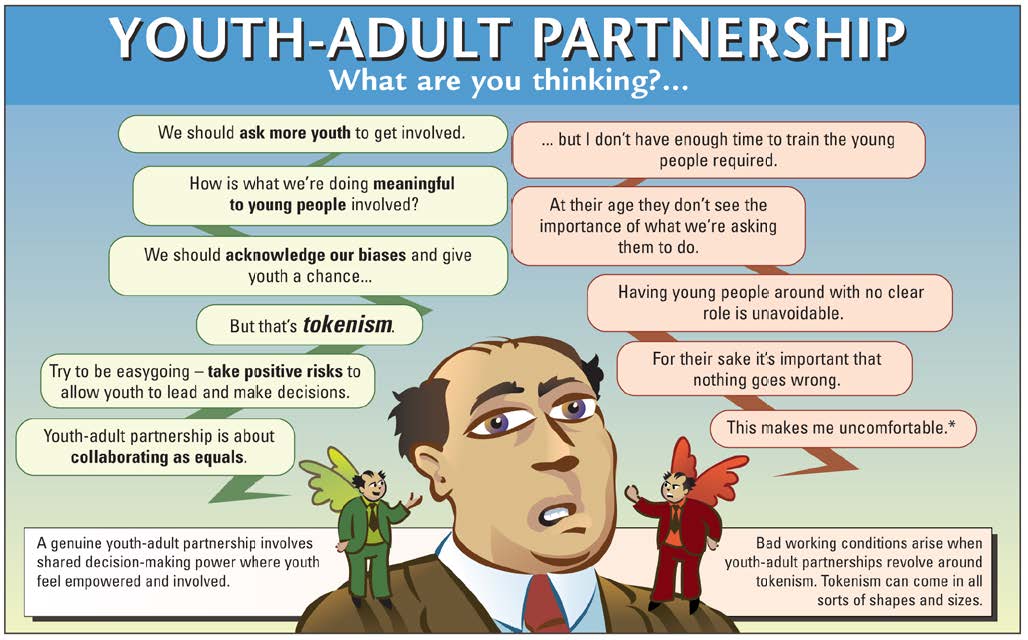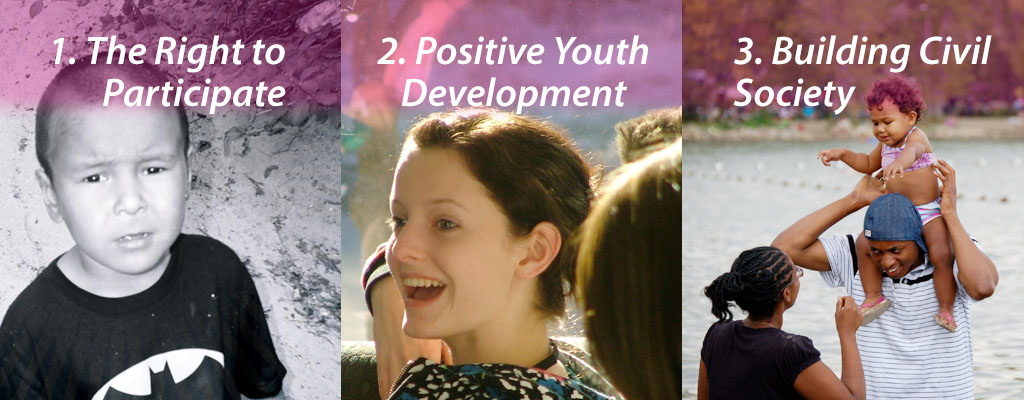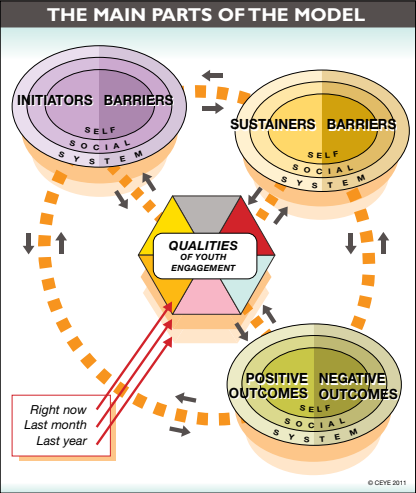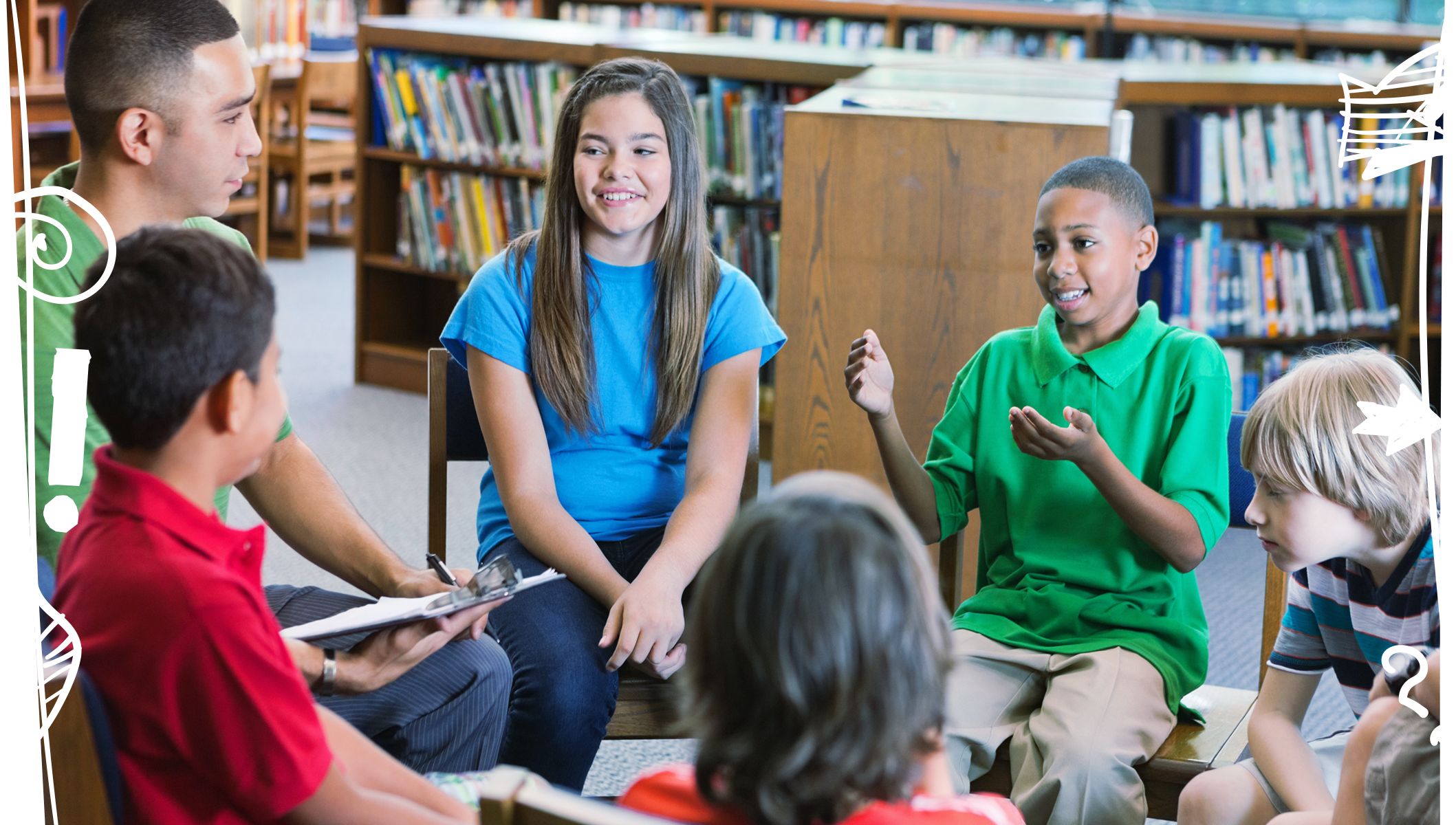Defining Youth Engagement
The Centre of Excellence for Youth Engagement defines youth engagement as the sustained and meaningful involvement of a young person in an activity focused outside of themselves.16 A closer look at this definition provides important hints for effective activities and practices:
- Sustained: Youth engagement that endures over time leads to positive outcomes. However, short and intense engagement experiences can also be effective if they satisfy the rest of the definition. Intense experiences often motivate sustained ones.
- Meaningful: The engagement activities and topics are relevant to young people – this can be assured if youth are asked to contribute to the development of the engagement activity.
- A focus outside the self: Youth are engaged when they feel connected and/or are contributing to something larger than themselves.
Full engagement consists of Head, Heart, Feet and Spirit components:
- Head: a cognitive component, e.g., learning new things
- Heart: an affective component, e.g., feeling excited
- Feet: a behavioural component, e.g., spending time doing an activity
- Spirit: a spirit component, e.g. connecting with other youth and adults to make change
Youth Engagement Defined
Defining Virtual Youth Engagement: What Does Youth Engagement Look Like Online?
Virtual youth engagement refers to the practice of intentionally involving young people in meaningful and interactive activities through digital platforms. This includes creating opportunities for youth to participate in discussions, educational programs, social events, and collaborative projects using online tools and technologies. Virtual youth engagement aims to foster connection, development, and empowerment by leveraging digital communication methods such as social media, video conferencing, online forums, and interactive learning platforms. It seeks to address the unique needs and interests of young people while providing a supportive and inclusive environment that encourages their active participation and growth in a virtual context.
For instance, interactive virtual events such as webinars and live Q&A sessions provide platforms for young people to participate, ask questions, and share their thoughts on topics of interest. Social media campaigns can also involve youth in content creation and sharing, encouraging their participation in broader conversations. Virtual clubs and groups centered around hobbies or social causes allow for structured engagement over shared interests, while online volunteering and service projects offer opportunities for contributing to social causes remotely.
The following illustrates some quotes from youth participants who attended the Students Commission’s #CanadaWeWant 2024 Conference.
Participation is the simple act of showing up; engagement occurs when head, heart, feet, and spirit are involved. Engagement is a process that is dynamic, reciprocal, and interactive, like a relationship. And just as every relationship is unique, there is no single right way to engage youth. However, there are some key common YE ingredients and promising practices for both in-person and virtual spaces outlined in this toolkit.
Why not just hold a focus group or a public consultation? What is the difference between a focus group and a youth engagement event?
Focus groups are designed for a one-way flow of information from the participants to the researcher or consultation host.
Head
“I learned about the variety and depth of experience of my peers.”
Heart
“I feel like I met new people and am excited to learn about others.”
Feet
“Keep learning everything I can from the people around me and try to create the opportunity for others to share their knowledge and wisdom with me.”
Spirit
“I feel like I felt a kinship with a lot of people, everyone here actually cares about the world and I’m happy I’m not alone.”
”Youth are full of great insight and can challenge the perceptions you hold and consider issues in great depth.
Researcher

”I’ll try my best to contribute in solving these issues.
Youth Participant#CanadaWeWant conference 2024
They are often critiqued by youth and other marginalized populations as not providing direct benefit to the participants, who never hear or know what happened with the information they contributed. Youth engagement is relationship-based and rooted in young people’s right to participate meaningfully in decisions that affect them. It sets up a reciprocal exchange of information and learning between adults and youth in a positive youth development context. Young people should have opportunities to share their ideas, ask questions, and be involved with designing and implementing new programs and policies. Their engagement should be sustained over time so they can take action on their ideas and see the results of their contributions. In a post-pandemic hybrid context, young people can actively contribute to the design and implementation of new programs and policies through various virtual methods. For instance, they can participate in online idea forums and brainstorming sessions, where they share and refine their suggestions. Digital surveys and polls can gather their opinions, while virtual youth advisory boards and interactive webinars provide platforms for in-depth discussions and feedback. Collaborative workshops also allow for the joint development of innovative solutions, and social media campaigns offer a space for broader engagement and idea sharing.
Youth Engagement: a Conceptual Model
Youth engagement experiences are complex and vary significantly depending on the context. To date, most of the research related to youth engagement has been focused on the “act” of being involved in activities, such as the type of activity and the frequency of involvement over time. However, youth engagement is more than just showing up to do certain activities: the process of engagement matters. The Centre of Excellence for Youth Engagement’s (CEYE) Conceptual Model17 provides a useful way to think about engagement, including the various factors that lead to and support meaningful engagement and positive outcomes.
When planning a youth engagement initiative, be deliberate about addressing all three levels of engagement.
Take a moment to think about the various features of the youth engagement model and what you are currently doing at your school, department, organization, or online to initiate and sustain youth engagement. What are the qualities of your engagement activities and what are the associated outcomes? Alternatively, if you are currently planning a hybrid or virtual youth engagement program, consider what needs to be in place in order to maintain engagement and connection. Use the CEYE Youth Engagement Model Worksheet to guide your reflection. This is a great activity to do in partnership with youth. See the Youth Engagement Model booklet for an explanation.
CEYE CONCEPTUAL MODEL OF YOUTH ENGAGEMENT
a dynamic process with four key components:
- Initiators (and barriers): Those things that encourage or hinder a young person from becoming engaged in an activity, organization, or process (they need volunteer hours to graduate, their friend brought them, they want to make a difference in their community, etc.)
- Qualities of a Youth Engagement activity: How an activity, program, or process is carried out – the key features (Young people are involved with setting goals, positive social norms, opportunities to belong, skill building, etc.)
- Sustainers (and barriers): Those things that keep young people engaged over a period of time, or cause them to disengage (Follow up activities and projects, adults report back to young people on the impact of their ideas, spaces and social networking for maintaining relationships, etc.)
- Outcomes (positive and negative): The impacts on young people, adults, programs, organizations, and the community as a result of the engagement process (a decrease in risk-associated behaviours, more effective youth policies, better relationships between youth and adults, etc.)
- The youth engagement process occurs at three levels:
- Individual or “Self” level: for example, a young person’s values, temperament, interest, etc.
- Social level: for example, the influence of friends, family, teachers, community, etc.
- System level: for example, opportunities or policies in schools, organizations, government, etc.
The Rationale for Youth Engagement
There are many important reasons to support youth engagement – from positive outcomes for young people, to better programs and policies. However, these three rationales emerge as the most prevalent:
Check out the Rationale for Youth Engagement handout
In-person engagement offers distinct advantages over virtual-only interactions, particularly in fostering deeper connections and enhancing communication effectiveness. Face-to-face interactions provide a richer, more nuanced experience through non-verbal cues, such as body language and facial expressions, which can strengthen relationships and build trust more effectively than virtual communication. In-person settings also facilitate spontaneous, informal conversations that can lead to creative ideas and solutions, and offer a tangible sense of community and shared presence that virtual environments can struggle to replicate. Additionally, in-person engagements can improve focus and reduce the distractions often present in virtual settings, leading to more productive and immersive experiences. While virtual interactions are convenient and accessible, in-person engagement remains invaluable for its ability to create meaningful connections and foster a collaborative atmosphere.
Those individuals who practice youth engagement on a day-to-day basis are well aware of the benefits, and they likely know these benefits from experience and not from research. Youth engagement makes programs more effective, policies more relevant, and adults and young people more capable and confident – resulting in stronger relationships and community. However, not everyone has experienced youth engagement firsthand, so how do we help others understand the benefits? What evidence and experience will convince decision makers that it is worth the time, effort, and resources to involve young people in governance, program and policy development, and implementation? A number of experts who have had to make the case for YE shared their best “elevator speech”:
The positive outcomes related to youth engagement are many – both for individuals and for society. See the Youth Engagement Outcomes handout. (For full references related to these impacts, please see the Literature Review)

”I feel good and confident about today. I’m glad that we got a lot done too. It also feels good to hear things from other people’s opinions. It’s hard to realize the harsh reality that’s going on in our community
Youth Participant
Program Evaluation Tool
Check out this versatile program evaluation, based on the CEYE youth engagement definition.
”I’ve connected more as I feel more open and safe, so I’ve used my voice more.
Youth Participant#CanadaWeWant conference 2024
Investing in Youth
“At some point, our investment in each youth will pay dividends for as they mature, they will be in leadership positions, making decisions. I would rather position ourselves as positive influencers in their personal growth now, than stand by and let other determinants influence them (quite possibly in negative ways). Ultimately human beings have an innate desire to be part of something, to belong. As a positive player in the social arena, we have the opportunity to create the conditions of belonging to foster positive personal development, and we must seize every opportunity possible.”
– Mellissa Wood, Department of Municipal and Community Affairs, NT (2014)
”Be realistic: just because you can’t do the ‘ideal’, you can still do bits of it well… start small and you’ll see success for youth and your organization
Annie SmithExecutive Director, McCreary Centre Society
”Youth engagement doesn’t always have to be expensive, or about money – it can be as simple as making a policy change or using existing resources in a new way”
Jill LightwoodDept. of Environment, Labour and Justice, PEI (2014)
”New ideas and faces have opened me to share my own thoughts and feelings. I felt like everyone was accepted and ‘fit in’, which is rare in my circle of friends at home. I am leaving the conference refreshed and with a new attitude.
Youth ParticipantTobacco Control Conference
”I will try my best to make the world a better place.
Youth Participant#CanadaWeWant Conference 2024
”I feel hopeful about a generation striving for change.
Youth Participant#CanadaWeWant Conference 2024
”Young people have the right to be consulted and have a voice.
Matt DeCourceyOffice of the Child and Youth Advocate, NB (2014)
”I feel happy that I was able to contribute
Youth ParticipantTobacco Control Conference
”I love engaging and sharing my thoughts
Youth Participant#CanadaWeWant Conference 2024



